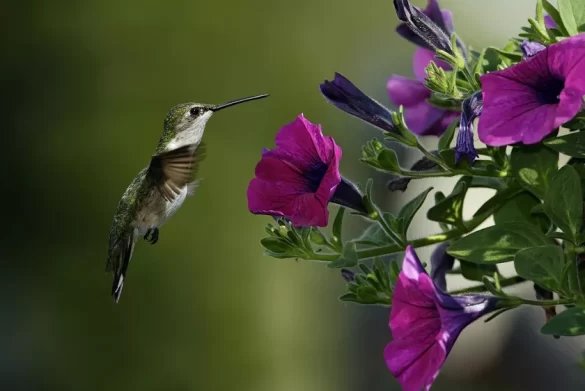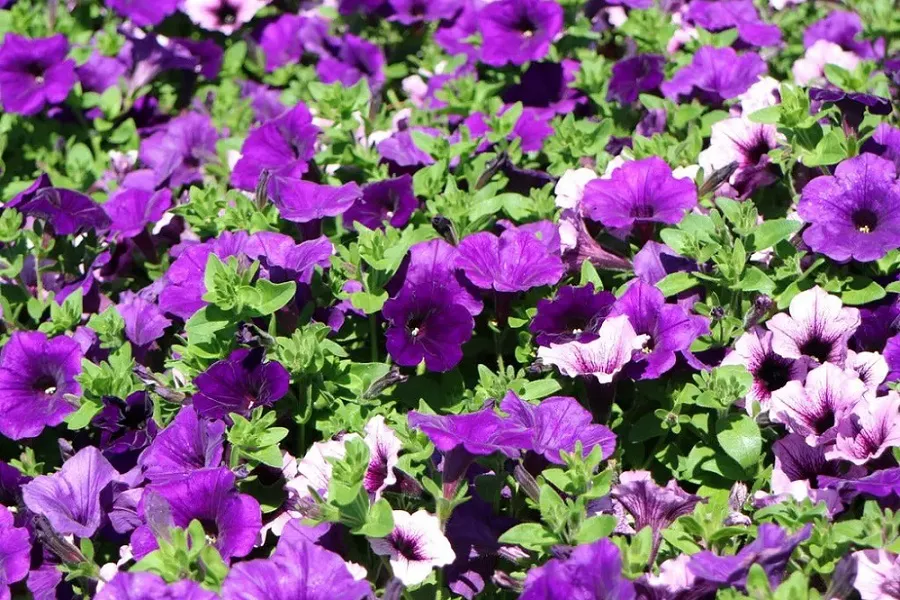Hummingbirds are among the most fascinating and beloved visitors in any garden. With their iridescent feathers and rapid wingbeats, they bring color and motion to flower beds and hanging baskets. For many gardeners, attracting hummingbirds is a source of joy and pride — and one of the most common questions asked is: Do hummingbirds like petunias?
The short answer is yes, hummingbirds do like petunias. These bright, trumpet-shaped flowers are both visually appealing and rich in nectar, making them a natural favorite. But to truly understand why petunias attract hummingbirds and how to maximize their appeal, we need to look deeper into hummingbird behavior, flower biology, and the conditions that influence their feeding preferences.
This article explores everything you need to know about the relationship between hummingbirds and petunias, including the best varieties to plant, how to arrange them for maximum attraction, and other complementary flowers to include in your hummingbird-friendly garden.
Understanding Hummingbird Feeding Behavior
Hummingbirds are nectar-feeding birds that rely on high-energy diets to sustain their rapid metabolism. These tiny creatures flap their wings up to 80 times per second and can visit hundreds of flowers daily.
Their favorite blooms typically share a few key traits:
- Bright colors such as red, pink, orange, and purple.
- Tubular or trumpet-shaped blossoms that match their long, slender beaks.
- A rich supply of nectar, which provides the essential sugars they need for energy.
While hummingbirds do eat small insects for protein, flower nectar is their primary energy source. This makes garden flowers — especially nectar-rich varieties like petunias — a vital part of their ecosystem.
See Also: Do Hummingbirds Like Mandevilla?
Why Petunias Attract Hummingbirds
Petunias are one of the easiest annuals to grow, and their shape and color make them perfect for hummingbird gardens. Here’s why these flowers are particularly attractive to hummingbirds:
1. Trumpet-Shaped Blooms
The funnel-shaped structure of petunia flowers fits perfectly with a hummingbird’s beak and tongue. It allows the birds to reach the nectar deep inside without damaging the petals.
2. Bright, Vibrant Colors
Hummingbirds have excellent color vision and are naturally drawn to vivid hues. Red, pink, purple, and magenta petunias are especially enticing because they stand out against green foliage and resemble the wild flowers these birds visit in nature.
3. Continuous Blooming Season
Petunias bloom from late spring through early autumn — overlapping perfectly with hummingbird migration and feeding periods. As long as the flowers are deadheaded (removing spent blooms), petunias keep producing nectar throughout the warm months.
4. Nectar Availability
Petunias produce a moderate amount of nectar, which, while not as high as some tubular species like salvia or honeysuckle, is still sufficient to keep hummingbirds visiting regularly, especially when planted in clusters.
The Best Petunia Varieties for Hummingbirds
Not all petunias are equally attractive to hummingbirds. Some hybrid or double-bloom varieties focus more on showy petals than nectar production, which can make them less useful for pollinators. To ensure your garden appeals to hummingbirds, consider the following types:
1. Grandiflora Petunias
These have large, ruffled blooms and come in vibrant colors. Though somewhat delicate in heavy rain, their wide trumpet shapes are easy for hummingbirds to access.
Recommended varieties:
- Daddy Red
- Storm Pink
- Ultra Violet
2. Multiflora Petunias
These petunias are smaller but more numerous, creating dense patches of color that hummingbirds love to explore. They’re also more weather-resistant.
Recommended varieties:
- Celebrity Mix
- Carpet Rose
- Primetime Red
3. Wave Petunias
Wave petunias are trailing types that spill over containers or garden edges. They create large, colorful carpets that can attract multiple hummingbirds at once.
Recommended varieties:
- Easy Wave Red
- Purple Wave
- Tidal Wave Hot Pink
4. Surfinia Petunias
A favorite among gardeners, these petunias are prolific bloomers that can handle heat and rain. Their nectar-rich flowers are irresistible to hummingbirds.
Recommended varieties:
- Surfinia Deep Red
- Surfinia Magenta
- Surfinia Sky Blue
How to Plant Petunias to Attract Hummingbirds
The way you arrange and maintain petunias can significantly influence how often hummingbirds visit your garden. Here’s how to create the ideal setup:
1. Use Clusters of Bright Colors
Plant petunias in clusters or masses rather than spreading them thinly. Hummingbirds are attracted to dense, colorful displays because they promise abundant nectar in one location.
2. Choose the Right Location
Petunias thrive in full sunlight and well-drained soil — both of which also appeal to hummingbirds. Place your petunia beds or containers in sunny areas near shrubs or trees that provide perching spots.
3. Mix Heights and Layers
Combine hanging baskets, window boxes, and ground-level plantings. Hummingbirds feed at various levels, so layered arrangements increase visibility and accessibility.
4. Provide a Water Source
Add a shallow bird bath or a hummingbird mister nearby. Hummingbirds enjoy bathing and drinking from moving water, which will encourage them to linger longer around your petunias.
5. Avoid Chemical Sprays
Insecticides and herbicides can harm hummingbirds directly or contaminate the nectar they feed on. Opt for natural pest control methods like neem oil or companion planting.
Pairing Petunias with Other Hummingbird Flowers
While petunias are attractive, combining them with other nectar-rich flowers can transform your garden into a true hummingbird haven. The goal is to ensure a steady supply of blooms from early spring to fall.
Here are some ideal companion plants:
Early Bloomers
- Columbine (Aquilegia): One of the first flowers to attract hummingbirds after migration.
- Bee Balm (Monarda): Bright and aromatic, perfect for spring and summer.
Mid-Summer Favorites
- Salvia: High in nectar and a top favorite among hummingbirds.
- Zinnia: Bright colors that complement petunias beautifully.
Late-Season Nectar Sources
- Trumpet Vine (Campsis radicans): A powerhouse of nectar late into the season.
- Lantana: Thrives in heat and provides abundant blooms until frost.
By combining petunias with these species, you’ll create a continuous bloom cycle that sustains hummingbirds all season long.
How to Maintain Petunias for Maximum Attraction
Hummingbirds prefer gardens where flowers look fresh and vibrant. To keep your petunias appealing throughout the season, follow these care tips:
1. Regular Deadheading
Remove faded blooms weekly to encourage new flower growth and continuous nectar production.
2. Fertilize Moderately
Use a balanced, water-soluble fertilizer every two weeks. Avoid over-fertilizing, which can promote leaf growth at the expense of flowers.
3. Water Consistently
Petunias need moist but well-drained soil. Water early in the morning to prevent fungal problems and keep nectar production stable.
4. Trim for Shape
Pinch back leggy stems to promote fuller growth and more blooms, ensuring a denser, more attractive patch for hummingbirds.
Observing Hummingbirds in Your Garden
Once your petunias begin blooming, you’ll likely see hummingbirds hovering nearby. These birds are territorial and may return daily to the same feeding spots.
To make the most of your observations:
- Place seating or viewing areas near your flower beds.
- Avoid sudden movements or loud noises.
- Use binoculars or cameras with zoom lenses to watch from a distance.
You’ll notice that hummingbirds establish routines, often visiting flowers in the same order every day. Their ability to remember reliable nectar sources means that your garden can become a regular stop on their feeding route.
Common Mistakes to Avoid
Even well-intentioned gardeners can make errors that reduce hummingbird visits. Avoid the following:
- Planting double-petal hybrids: These flowers look fancy but often have less nectar.
- Ignoring sunlight needs: Petunias in shade produce fewer blooms.
- Using synthetic pesticides: These can deter or harm hummingbirds.
- Neglecting deadheading: Faded flowers signal reduced nectar supply.
By maintaining natural, vibrant, and chemical-free petunias, you’ll create a safe and abundant food source.
Additional Tips for a Hummingbird-Friendly Garden
Add Feeders for Consistency:
Place red hummingbird feeders near petunia beds to supplement nectar when blooms are sparse. Use a simple mix of four parts water to one part white sugar — no dyes needed.
Provide Shelter:
Hummingbirds rest in trees or shrubs between feedings. Plant native species like lilac or viburnum nearby for cover.
Plan for Migration:
In North America, hummingbirds migrate in spring and fall. Keep petunias blooming through both periods to support their long journeys.
Use Native Plants:
Pair petunias with native flowers that hummingbirds recognize, improving your garden’s ecological balance.
Frequently Asked Questions (FAQ)
Do hummingbirds like geraniums?
Hummingbirds may occasionally visit geraniums, but these flowers are not among their top choices. Geraniums produce limited nectar compared to tubular flowers. To attract more hummingbirds, consider pairing geraniums with nectar-rich plants like salvias, petunias, or fuchsias.
Do hummingbirds like begonias?
Most begonias are not especially attractive to hummingbirds because they have less nectar and smaller blooms. However, some varieties with bright red or orange tubular flowers can draw occasional visits. For consistent hummingbird activity, choose flowers with more nectar and easier access to deep blooms.
Do hummingbirds like hibiscus?
Yes, hummingbirds love hibiscus flowers. The large, trumpet-shaped blooms and bright colors—especially red, pink, and orange—are ideal for hummingbirds. Hibiscus plants provide ample nectar and are a great addition to any hummingbird garden.
Do hummingbirds like impatiens?
Impatiens can attract hummingbirds occasionally, but they are not a primary nectar source. These flowers offer some color appeal, especially in shaded gardens, but they lack the nectar volume that hummingbirds prefer. Mixing impatiens with tubular blooms like salvia or columbine helps increase visits.
Do hummingbirds like calibrachoa?
Yes, hummingbirds are often drawn to calibrachoa, also known as “Million Bells.” These small, petunia-like flowers come in vibrant colors and have tubular shapes perfect for hummingbird feeding. Calibrachoa blooms continuously through the warm months, making them a reliable nectar source.




 Facebook
Facebook  Instagram
Instagram  Youtube
Youtube 